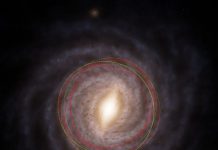
The Geminids meteor shower is a winter spectacle that lights up our night sky every year.
However, the origins of these “shooting stars” have been a mystery for scientists until recently.
Unlike most meteor showers, which are born from icy comets, the Geminids have an unusual parent: an asteroid named 3200 Phaethon. This has intrigued astronomers, as asteroids, made of rock and metal, typically don’t give off trails like comets do.
Researchers from Princeton University have now used NASA’s Parker Solar Probe mission data to shed light on this puzzle.
Their study, published in The Planetary Science Journal, suggests that a catastrophic event, like a high-speed crash or a giant explosion, likely created the Geminids meteor shower.
Jamey Szalay, a research scholar at Princeton University and co-author of the study, explains that understanding asteroids helps us understand the history of our solar system, as they are “little time capsules” formed alongside the planets.
Lead author of the paper, Wolf Cukier, an undergraduate student at Princeton, highlighted the peculiar nature of the Geminids meteor shower.
The Geminids stream orbits slightly outside of its parent body, 3200 Phaethon, when closest to the sun, a phenomenon that puzzles scientists.
Typically, a comet sheds ice and dust when it heats up near the sun, forming a tail and eventually a meteoroid stream. However, asteroids like 3200 Phaethon, being composed of rock and metal, don’t react to the sun’s heat in the same way.
Yet, 3200 Phaethon displays some temperature-driven activity when it passes by the sun, which is unusual for asteroids.
Using data from the Parker Solar Probe, the researchers simulated various scenarios for how the Geminids stream could have formed. The scenarios ranged from a “basic” model, where material was released from the asteroid with no speed or direction, to a “violent” model, where the material was ejected at high speeds due to a catastrophic event. They also considered the standard cometary model.
On comparing these simulations with real data from the probe, the researchers found that the violent model was the best match. This suggests a sudden, catastrophic event, like a high-speed collision or an explosion, likely caused the creation of the Geminids meteor shower.
This research wouldn’t have been possible without the unique capabilities of the Parker Solar Probe. It doesn’t directly measure dust particles, but it can track them as they hit the spacecraft, creating plasma clouds and unique electrical signals.
The probe is gathering first-of-its-kind data that scientists will analyze for many years to come, to understand more about our solar system and the universe.
Cukier’s pursuit of this project was fueled by his passion for outer space and the support of his department at Princeton University. He hopes his research will inspire others to appreciate the beauty and wonder of our universe.
And there’s an easy way to do it: just look up.
On December 14, you can see the Geminids meteor shower – a cosmic display that’s the result of a massive celestial collision that happened billions of years ago. It’s not only a beautiful sight but also a glimpse into the history of our solar system.
Source: Princeton University.



